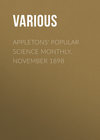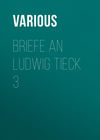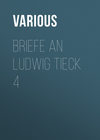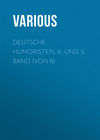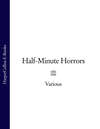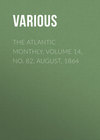Buch lesen: «Appletons' Popular Science Monthly, November 1898», Seite 7
THE HERDS OF THE YELLOW ANT
By JAMES WEIR, Jr., M. D
As far as my observations go, and they extend through a period of twenty years, the aphides which live on grapevines, and which are the peculiar cows of the common yellow ant (Lasius flavus) of our gardens, show many curious phases in their life history. Especially is this true of the manner in which they perpetuate their species.
If a colony of aphides be kept under observation during the summer, it will be noticed that several kinds of individuals arise within it. By far the largest number of the herd will be made up of the wingless agamic form – that is, of females which reproduce without mating. In the species under consideration the young (during the summer) are born alive, and do not come from eggs.
So rapid is the increase of these insects that overproduction would soon kill off the colony by starvation were it not held in check by the peculiar anatomical and physiological metamorphoses which make their appearance in the offspring from time to time. Every now and then young ones are born which, in the course of time, evolve two pairs of wings; these winged individuals (which are also females and agamic) abandon the colony and produce elsewhere, in turn, wingless and single-winged individuals. In autumn both males and females are born; these mate and the females lay eggs.
These creatures secrete a honeylike fluid which exudes from two tubelike teats on the back of the sixth abdominal segment. Ants are passionately fond of this honey-milk and jealously guard and protect the herds of aphidian cows which produce it. They can be seen at all hours of the day, busily engaged in milking their queer kine. They will gently stroke the aphides with their antennæ, thus inducing a free flow of the nectar from the abdominal tubules. Calves effect a like result by nudging their mothers with their heads; the cows "give down" their milk when thus assaulted by the calves.
In autumn, as soon as ovipositing has begun, the ants gather the aphis eggs as fast as they are laid and carry them into their nests. Here they remain, carefully guarded and protected by the ants, until they hatch out in the spring, when the young agamic females are carried out by their foster mothers and placed upon the tender grape shoots or buds. This year the ants brought out the young aphides, which formed the herds kept under observation this summer, on the 18th of March. On the 19th they carried them back into the nest; this occurred in the forenoon, when the sun was shining and the air was warm and balmy. About 12 M. it began to storm, and became quite cold; that night there was a hard frost. The ants evidently knew that this change in the weather was about to occur; therefore they removed their property to a warm and sheltered place. I have often watched the ants in autumn when the aphides were ovipositing; the former would caress the latter, and seemingly would endeavor to stimulate and cheer them during the operation. As soon, however, as the eggs were deposited, the ants would seize and carry them into the nest; the aphis mother was left, without any compunctions whatever, to die during the first frost! Her life work had ended, and the economy of Nature needed her no longer.
Ants are always on the lookout for the new colonies which are continually being started by the winged females. As soon as one of these new herds is found by an ant, she returns to the nest and notifies her companions. One or two ants then accompany her to her newly found treasure, which in future is always, night and day, under their watchful care. As the herd increases in numbers, additional herdsmen, or rather dairymaids, are called into service.
Associated with this species are commonly to be found other species of aphides, notably the one which secretes, or rather excretes, a white powdery substance which is to be seen on their backs in soft, plumose masses. On microscopic examination this substance is found to be fairly teeming with microbia. These microbes, at the first glance, seem to be of different species; maturer judgment, however, declares them to be but metamorphic forms of the same individual.
A "white" aphis can be seen in the photograph at the base of the upper leaf stem. With a small pocket lens the details of this creature's structure can be easily made out. There are several of these aphides on the vine, but the one mentioned is the largest and the most conspicuous. They are much larger than the nectar-producers, are oval in shape, and distinctly flattened. In fact, in general outline they are strikingly like that bête noire of all good housekeepers – the Cimex lectularius. The ants frequently congregate about these little creatures and appear to be paying them some kind of court. When I cut the vine for photographic purposes, six or eight ants were standing about the large individual mentioned above; they soon became aware that some dire calamity had happened, or was about to happen, either to their beloved herd or to themselves, and, becoming frightened, soon abandoned cattle and pasture and fled away in panic terror. I had hoped to photograph them in situ, but found this to be impossible with the instruments at my disposal.
The ants do not "milk" these white aphides, neither do they eat the excrementitious substance on their backs. The white individuals, however, seem to be factors in the social economy of the herd, for the ants move them, on occasions, along with the herd to other pastures. Once I saw an ant pick up a white aphis and carry it to a leaf some little distance away from the colony; she then returned, picked up a gravid nectar-producing aphis, and carried her to the spot where she had left the white individual. In a few days a fine herd of "milkers" was to be seen grazing in the new field. I judge from this that these white aphides are in some way useful to, if not absolutely necessary for, the welfare of the herd.
The winged females have both compound eyes and ocelli, or primitive eyes, yet they seek the under surface of the leaf, thus seeming to prefer the more subdued light to be found there. The young are always deposited on the under surface of the leaves; in a few days, however, they either migrate of their own accord to the more succulent stems or are carried thither by the ants, which never cease to watch over and care for them.
In order to test this guardianship, I have frequently wounded the vine below a colony of aphides, thus cutting off, to a certain extent, the flow of sap. The ants would soon discover this and would at once begin to move the herd to another vine. The aphis is provided with boring and suction organs somewhat similar to those of the mosquito. In point of fact, it is interesting to note that the ancestors of the mosquito, in all probability, lived wholly on the juices of plants; hence, in this respect, the resemblance is more real than apparent. Aphides, also, like mosquitoes, have the curious habit of elevating their bodies, "standing on their heads," after they have become gorged with food; this can be observed in the drawings.
The cow of the yellow ant should not be confounded with her harmful cousin, Phylloxera vastatrix, the deadliest enemy of the grape. Fortunately for us, this last-mentioned aphis does not abound in the United States; in France and other European countries, however, phylloxera has occasioned the loss of millions of dollars.
Notwithstanding the fact that the ants are exceedingly zealous in guarding their property, many of the aphides fall victims to the assaults of their enemies. The most cunning, insidious, and crafty of their foes are the ichneumon flies, three varieties of which are continually, during the summer months and in autumn, endeavoring to cradle their young in the bodies of the aphides.
One of these flies, which can be seen in the drawing, is quite large; I am inclined to believe, therefore, that their larvæ do not pupate in the bodies of their hosts, but undergo further metamorphoses elsewhere. Another of these flies is very small, hardly larger, in fact, than the insect which it selects as a living cradle for its young. The ichneumon shows rare intelligence, inasmuch as she invariably deposits her eggs on the young members – the calves, as it were – of the herd; she seems to know that the older aphides would die before the ichneumon grubs arrived at a suitable age for pupation; hence she selects the young ones. She runs here and there about the colony until she finds a young aphis; then, curving her abdomen between her legs, she will quickly lay an egg on the body of the unconscious insect. When the egg hatches the larva feeds on the body of its host (carefully avoiding the vital organs, however) until the time arrives for it to undergo further metamorphoses. The animated cradle and cupboard eventually dies, but not until its queer baby has arrived at an age at which it has no further use for it.
The ants are fully aware of the fact that the ichneumon is a deadly enemy of their cows; hence, when one of these flies is seen hovering over the herd, they at once become alert and endeavor to chase her away whenever she alights. She manages, however, to elude them every now and then, and to lodge her fatal eggs on some of the tender young aphides.
Another implacable foe of these creatures is the larva of a neuropterous insect which in its perfect or mature form resembles the dragon fly. It is technically known as an aphis-lion, and differs very widely in habits from the common and well-known ant-lions. The last-mentioned grubs dig pits, at the bottoms of which they lie in wait for and seize their prey whenever it falls therein; the aphidian lion is, on the contrary, a bold and skillful hunter, and takes its prey wherever it may find it. It is an ugly, heavy, slothful-looking grub, yet it is remarkably agile. When darting upon its quarry (and it hunts the winged aphides only), its thick, clumsy-looking legs move with such rapidity that they can scarcely be seen. Its movements as well as its shape are decidedly lacertilian; in fact, when it is seen coursing over the grape leaves in pursuit of its prey, it reminds one irresistibly of the brilliant little lizards which are to be observed running here and there over stone walls, fences, and sunny woodland paths. This creature stalks its prey like the lycosids or hunting spiders, and fairly bounds upon it when it arrives within grasping distance. Its catlike movements when creeping up on its quarry are wonderful to behold, and indicate a very high degree of intelligence.
In color it is jet black; in fact, in certain lights it glistens like a jet jewel. It is about half an inch long and one sixteenth of an inch broad. On the margins of its body, from its head to its tail, are rows of thorn-like spines. Its masticatory organs, as well as its viscera, are much more highly developed than are those of ant-lions. It is a brave little creature, and only succumbs to the ants (which make war on it wherever they find it, thus showing that they are fully aware of the fact that it is inimical to their herds) when life ceases. During the last twenty years I have frequently observed this larva, and have endeavored to follow it in its metamorphoses. I have succeeded only once, however, in carrying it through to its imago or perfect form. It is not described in any of my lists, and may be, therefore, a new species. There is another aphis-lion which in very many respects closely resembles the one just described. It is pictured by Professor Comstock, a modification of whose drawing is here produced. He writes of this creature as follows:
"When the aphis-lion is full grown, it rolls itself up into a tiny ball and weaves around itself a glistening, white cocoon, which looks like a seed pearl." (This can be seen in the sketch near the base of the upper leaf.) "It may be supposed that while the aphis-lion is secluded in this pearly cell it repents its greedy, murderous ways, and changes in spirit; at least the body changes greatly, for, after a time, a circular lid is made in the cocoon, and out of it there emerges a beautiful, dainty creature, with delicate-veined, green wings, a pale-green body, slender brown antennæ, and a pair of large eyes that shine like melted gold. It is sometimes called golden-eyes, and sometimes a laced-wing fly, from its appearance."
This beautiful little insect evinces marvelous forethought in the matter of perpetuating her kind. She knows that her young are predaceous, devouring anything in the shape of an insect or an egg that they can secure; she is aware of the fact that, if she were to deposit her eggs, side by side, on a leaf, the first young aphis-lion hatched out would devour all of the remaining eggs. In order to guard against this, she spins a delicate but stiff stalk of hard silk, upon the tip of which she deposits an egg. By the side of this stalk she rears another, and another, and another, tipping each with an egg, until finally, when she has finished ovipositing, there appears a miniature grove of delicate silken stems, each one of which bears aloft on its summit a round and shining egg. When the first-born of this brood makes its appearance, it crawls down the stem to the surface of the leaf, and goes in search of food, utterly unconscious of the rich and toothsome feast just above its head on the tips of the other stalks!
Lubbock concludes, from certain experiments, that the yellow ant will not voluntarily drop from an elevation. Now, observations and experiments made by myself teach me that these ants (Lasius flavus) will drop from elevations when they wish to attain a certain object.
On one occasion one of the herds of aphides under observation was discovered by a wandering black ant (Lasius niger), which reported her discovery to her comrades. At once a marauding expedition was inaugurated by these cattle thieves, which fiercely attacked the yellow guardians of the herd. The black rievers swarmed up the grapevine, but were met by the brave yellow warriors, which valiantly withstood their attack. Finally, the yellow ants were in danger of being overwhelmed by numbers, when I suddenly perceived that they were being re-enforced. Closer examination revealed the fact that they were crawling up a neighboring vine and then dropping from an overhanging leaf on to the leaf on the stem of which the aphides were feeding. They could not reach the herd by way of the original path on account of the intervening army of black ants, hence their shrewd and most intelligent use of the neighboring vine and overhanging leaf. I am glad to report that the yellow ants were victorious, and that they completely routed the would-be robbers.
When alarmed, the yellow ant will draw in its legs and drop to the ground; moreover, this is characteristic of all vine- and tree-climbing ants, Lubbock to the contrary notwithstanding. It stands to reason that past experiences must have taught them that they received no injury from involuntary tumbles; that they have evolved the habit of voluntarily throwing themselves from an elevation in order to attain certain objects does not seem to me, therefore, at all wonderful or extraordinary.
TWO GIFTS TO FRENCH SCIENCE
By M. HENRI DE PARVILLE
M. Antoine Thomson d'Abbadie, of the Academy of Sciences and Bureau of Longitudes, France, who died in Paris, March 20, 1897, was born in Dublin, January 3, 1810, of a family of the Basses-Pyrénées temporarily residing in Ireland, but which returned to France in 1815. The d'Abbadies are said to have been descended from the lay monks instituted by Charlemagne to defend the frontier against the incursions of the Saracens. The name d'Abbadie was not originally a proper name, but the title of a function (abbatia abbadia), and designated those soldiers who lived in the abbeys of the Basque country, lance in hand. Hence the name, which is well diffused, whether spelled with two bs or one.
While still very young Antoine d'Abbadie manifested an unusual curiosity concerning the unknown around him. "What is there at the end of the road?" he asked his nurse. "A river," she replied. "And what is beyond the river?" "A mountain." "And what then?" "I don't know; I never was there." "Well," said he, "I will go and see." He was the same as he grew up, always wanting to know. He visited Brazil upon a mission for the Academy of Sciences, and on his return joined his brother at Alexandria.
Unknown Ethiopia attracted his attention, and he engaged with his brother Arnould in archæological researches. Archæology proved unfruitful, and the two brothers took up geodesy. For eleven years Antoine d'Abbadie traveled though Ethiopia, living the life of the natives, and making himself master of the five Abyssinian dialects. The exploration was difficult and sown with dangers. Antoine d'Abbadie covered the country from Massouah, on the shore of the Red Sea, to the interior of the land of Kaffa, which he was the first to visit, with a triangulation that involved the fixing of five thousand positions at five hundred and twenty-five successive stations. The distance between Massouah and Mount Wocho in southern Kaffa is about one thousand kilometres, a little more than the crossing of France along the meridian of Paris, and the trigonometric network reached two hundred and fifty kilometres in breadth. Antoine d'Abbadie remained in Gallaland from 1837 to 1848. The labors of the two brothers, too numerous to cite here, concerned also ethnography and linguistics. Both were nominated Chevaliers of the Legion of Honor on the same day, September 27, 1850. The doors of the Academy of Sciences were opened to Antoine d'Abbadie August 27, 1867, and he was named a member of the Bureau des Longitudes in 1878. He was in charge of the observation of the transit of Venus in Santo Domingo in 1882.

Fig. 1. – Château d'Abbadie. General view. (A gift to the French Academy of Sciences.)
Instead of devoting himself to a specialty, as is done now to excess, d'Abbadie pursued the scientific movement in its various forms, and was at once an astronomer, geodesian, archæologist, ethnographer, numismatist, and interested in other fields. With his noble character he made himself esteemed and loved during his whole working life by all so fortunate as to make his acquaintance. In an interview I had with him a few weeks before his death, when his disease had already gained a strong hold upon him and he was nearly speechless, he expressed himself freely concerning the future, although he uttered every word with difficulty, and it was easy to see that it caused him pain. The topic was science, and he wanted to talk about it.
When he was president of the Academy of Sciences, a few years ago, he sacrificed himself to be equal to the honor that had been conferred upon him. Speaking was already becoming very difficult to his tired vocal organs. He made extreme efforts during the whole year to fulfill his duty as president, and was punctual at the Monday sessions to the end.
In 1896, feeling the advance of age, he determined to make a splendid present to the Academy of Sciences. The Duc d'Aumale had given Chantilly to the Institute. M. Antoine d'Abbadie gave the Academy of Sciences his magnificent Château d'Abbadie, near Hendaye, in the Basses-Pyrénées, on the coast of the Bay of Biscay. The academy will enter upon the possession of this property, of three hundred and ten hectares of land surrounding it, and of a capital producing a revenue of forty thousand francs (eight thousand dollars) after the death of Madame d'Abbadie. Only a single condition is imposed on the gift. Having carried on his astronomical work at Abbadia and begun there to catalogue the stars and study the variations of gravity, he asked in exchange for his incomparable gift that the academy should complete in fifty years a catalogue of five hundred thousand stars. The bureau of the academy dispatched its president, M. Cornu, and its perpetual secretary, M. Bertrand, to Abbadia as its representatives to express its gratitude to M. and Madame d'Abbadie. The faith of the academy was pledged to continue the work begun by M. d'Abbadie, and a commemorative medal was given him bearing on one side a portrait of Arago, and on the other a minute of the gift and the thanks of the company.
The Château of Abbadia will therefore be devoted to the determination of the stars that are not yet catalogued. Probably, as was the donor's thought, the religious orders or some of the secular priests will perform this colossal labor. The chaplain of the château has already given his service to the work. In any case, those who may live in the château will have no cause to complain of their home. Abbadia is a very interesting structure, built from plans by Viollet-le-Duc, modified and carried out by the architect Duthoit, with suggestions of the fourteenth and sixteenth centuries. The observatory adjoins the château, which it antedates thirty years in building, and has a meridian telescope and the essential astronomical instruments. In the deep cellar of the observatory M. d'Abbadie made more than two thousand seismic observations with the pendulum.
The château stands in an admirable situation, and presents a very fine external aspect. We give a general view of it and a picture of the main entrance. The interior decoration is very beautiful.

Fig. 2. – Principal Entrance to the Château d'Abbadie.
Those who have had the privilege of visiting Abbadia have remarked that a stone is missing from the balcony of one of the windows; this stone, according to the wishes of the donor, is never to be put in place. A history is connected with its absence. M. d'Abbadie, in the course of a journey in America, contracted a strong friendship with Prince Louis Napoleon, who was then in the United States. The prince once said to him, "If I ever come into power, whatever you may ask of me is granted in advance." The prince became Emperor of the French. Napoleon III had a good memory. He met his former companion one day, and said to him in an offhand way: "I promised when we were in America to give you whatever you would ask for; have you forgotten it?" M. d'Abbadie replied: "I have built myself a château near Hendaye, where I hope to spend the rest of my days. If you will be so kind as to go a few kilometres out of the way for me during your coming visit to Biarritz, I shall consider myself highly honored if you will lay the last stone of my house." Napoleon smiled and promised. But that was in 1870, and Napoleon III never returned to Biarritz. That is the reason a stone is missing at Abbadia.
An account is also appropriate here of that other gift to French science and letters of the Château of Chantilly, made to the Institute of France in 1886, by the late Duc d'Aumale, whose tragic death in consequence of the terrible disaster at the Bazaar de Charité, Paris, occurred near in time to that of M. d'Abbadie. The duke was conspicuous as a soldier, as a man of letters, the author of the History of the Princes of Condé, and as a great bibliophile; as a member of the French Academy (1871), taking the place of Montalembert; of the Academy of Moral and Political Sciences, and of the Academy of Fine Arts; and as a patriot, though a banished prince. The gift was made three months after the decree was issued banishing the Orleans princes from France, and after the duke had expostulated with M. Grévy in vain against the step. The deed reads: "Wishing to preserve to France the domain of Chantilly in its integrity, with its woods, lawns, waters, buildings, and all that they contain – trophies, pictures, books, objects of art, and the whole of what forms, as it were, a complete and various monument of French art in all its branches, and of the history of my country in its epochs of glory – I have resolved to commit the trust to a body which has done me the honor of calling me into its ranks by a double title, and which, without being independent of the inevitable transformations of societies, escapes the spirit of faction and all too abrupt shocks, maintaining its independence through political fluctuations. Consequently, I give to the Institute of France, which shall dispose of it according to conditions to be hereafter determined, the domain of Chantilly as it shall exist on the day of my death, with the library and the other artistic and historical collections which I have formed in it, the household furniture, statues, trophies of arms, etc." The sole condition attached to the gift was that nothing should be changed at Chantilly. The chapel, where the heart of Condé is deposited, should be retained, devoted to worship, with special masses to be said at stated times, and the splendid collections of the château should together be called the Condé Museum. In 1889 the Government authorized the duke to return to France. He refused to accept the permission as a matter of favor, but only as one of right. He returned, however, and took his seat in the academy in May of that year. —Translated for the Popular Science Monthly from articles in La Nature.

Fig. 3. – The Château of Chantilly.
(Presented by the late Duc d'Aumale to the Institute of France.)
